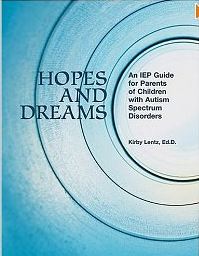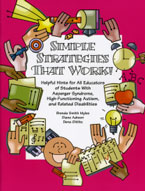 Yes, it’s that time of year again – Time for the annual review of my son’s Individualized Education Plan (IEP). Even though this is only a review of our existing plan, and things have been going really well for my son this year, I still feel nervous and concerned. Let’s face it, the entire process is extremely intimidating and nerve-wracking to a parent. Without fail, I don’t sleep the night before, I can’t eat anything that morning and during the meeting – I cry… Yep, no matter if what is said about Gregory is positive or negative….I cry. (Trust me – crying when receiving good news is even more mortifying than crying when receiving bad news…. ;-\) I can’t help it; so much of myself (my efforts, my concerns, my dreams, my love, etc.) is wrapped up in my children, the emotion and the nerves just get too much for me to contain. Well, that and the fact that I’m a total sap…
Yes, it’s that time of year again – Time for the annual review of my son’s Individualized Education Plan (IEP). Even though this is only a review of our existing plan, and things have been going really well for my son this year, I still feel nervous and concerned. Let’s face it, the entire process is extremely intimidating and nerve-wracking to a parent. Without fail, I don’t sleep the night before, I can’t eat anything that morning and during the meeting – I cry… Yep, no matter if what is said about Gregory is positive or negative….I cry. (Trust me – crying when receiving good news is even more mortifying than crying when receiving bad news…. ;-\) I can’t help it; so much of myself (my efforts, my concerns, my dreams, my love, etc.) is wrapped up in my children, the emotion and the nerves just get too much for me to contain. Well, that and the fact that I’m a total sap…
Anyway, in the hope of helping other parents in a similar position (criers or not!), I am dedicating this series of blog posts to ways to make the most of your child’s IEP process. I’ve received a number of comments and questions on my blog regarding IEPs, so I know I am not alone in my feelings.
 A good IEP is a vitally important support for your child’s future, but the entire process is confusing, fraught with emotion, and bounded by fears that even though your child is counting on you, you might not be up to the task. With so much riding on it, no wonder parents feel so daunted, anxious and overwhelmed! Maybe a few of these suggestions will help.
A good IEP is a vitally important support for your child’s future, but the entire process is confusing, fraught with emotion, and bounded by fears that even though your child is counting on you, you might not be up to the task. With so much riding on it, no wonder parents feel so daunted, anxious and overwhelmed! Maybe a few of these suggestions will help.
Be forewarned – this is going to be a long post. This is an important topic with a lot of ground to cover…. So as not to overwhelmed you, I’ve broken the subject into several posts. This first post in the series focuses on the up-front legwork needed to help the IEP process go more smoothly. So, grab a cup of coffee, take the phone off the hook and settle in…
Does Your Child Need an IEP?
 You know that your child is struggling and needs help….The very first thing you must do is determine whether or not your child needs services from the school’s Special Services, or if other paths might be a better approach. Here are a few questions to ask yourself objectively:
You know that your child is struggling and needs help….The very first thing you must do is determine whether or not your child needs services from the school’s Special Services, or if other paths might be a better approach. Here are a few questions to ask yourself objectively:
1. Must your child’s needs be met during school (i.e. academic support, resource room, etc.) or might they be better met in another setting, such as tutoring at home, physical therapist (PT) at the clinician’s office or social skills in a group setting? (Finances, of course, play into this equation, since many times medical insurance doesn’t [fully] cover these types of services…)
2. So, you’ve identified that your child needs help during school. Now, can these needs be met within General Education, instead of Special Education?
- My advice would be to try more direct methods first, by working directly with the General Education teacher and Guidance Councilor. Together, you may be able to provide additional supports, behavior modifications, etc. within the general education classroom that would not require that your child to be officially ‘classified’ within the Special Education department. For example, teachers will frequently spend extra time with a child who needs extra help. Small group instruction (pull-out/resource room) may also be available for specific subjects.
- The school may decide that a formal Intervention and Referral Services (INRS) team meeting is required to discuss your child’s needs and possible interventions. This can be a good thing, as it formalizes your child’s issues and any agreed upon interventions.
 3. You’ve identified that your child needs help during school, but the unofficial assistance or INRS interventions are not sufficient. Is your child eligible for Special Services? To determine this, you must formally request (in writing) that your child be evaluated by the Child Study Team (CST) of your school or district. The CST is made of up two or more certified personnel, including the school psychologist, learning disabilities teacher and social worker. This evaluation will assess your child functionally, academically, behaviorally and psychologically to determine where any issues or deficits exist. The evaluation will be based on standardized testing, observations, interviews and a review of developmental and educational history.
3. You’ve identified that your child needs help during school, but the unofficial assistance or INRS interventions are not sufficient. Is your child eligible for Special Services? To determine this, you must formally request (in writing) that your child be evaluated by the Child Study Team (CST) of your school or district. The CST is made of up two or more certified personnel, including the school psychologist, learning disabilities teacher and social worker. This evaluation will assess your child functionally, academically, behaviorally and psychologically to determine where any issues or deficits exist. The evaluation will be based on standardized testing, observations, interviews and a review of developmental and educational history.
- A specific diagnosis of your child’s problem(s) by an outside doctor or professional may be helpful, but it is not necessary. The IEP eligibility determination is based on academic performance and behavioral issues at school, with or without a formal diagnosis.
- In any case, don’t wait to obtain a diagnosis report from your doctor before requesting the CST evaluation. The process takes several months to complete and the school is not required to accept an outside diagnosis or recommendation. The school may in fact, decide to hire its own doctor to conduct an assessment during the evaluation process.
Special Note: If your child’s teacher or Guidance Councilor is the one who raises concerns and recommends an evaluation, be open to hearing a difficult ‘truth’. It may be a shock to you, or you may already have had concerns of your own, but it still can be hard to acknowledge that your child is struggling. It won’t help your child for you to deny that their difficulties exist, so stay focused on your child’s best interest. Keep in mind that teachers see many children over the years, so they can be more objective about identifying when problems exist. They also see your child in a different setting and circumstances that you do. It doesn’t mean the teachers/councilors are always correct, but it is at least worth listening to their concerns and perspectives.
On the plus side, if the school suggests the evaluation, you are much less likely to have a battle on your hands to get the help that your child needs. And rest assured, no evaluation may be conducted on your child without your written permission.
Preparation
So….you’ve decided to pursue an evaluation by the CST. Now it is time to do your homework! To make the most of the IEP process, it is vital that you do adequate preparation. You are the expert on your child and must stand as his staunchest advocate. So, be sure to cover these following steps for the best outcome for your child.
1. Understand your Child
 Take time to really understand your child’s strengths, weaknesses, personality traits and interests. Be specific about your goals and desired outcomes. It is not enough that your want your child to be ‘happy’ or to ‘reach his full potential’. You need to have concrete goals, such as ‘read at grade level’, ‘ interact appropriately with peers’, etc. A great tool to help parents with this soul-searching step is Hopes and Dreams – An IEP Guide for Parents of Children with Autism Spectrum Disorders, by Kirby Lentz, Ed.D.
Take time to really understand your child’s strengths, weaknesses, personality traits and interests. Be specific about your goals and desired outcomes. It is not enough that your want your child to be ‘happy’ or to ‘reach his full potential’. You need to have concrete goals, such as ‘read at grade level’, ‘ interact appropriately with peers’, etc. A great tool to help parents with this soul-searching step is Hopes and Dreams – An IEP Guide for Parents of Children with Autism Spectrum Disorders, by Kirby Lentz, Ed.D.
2. Educate Yourself
To adequately prepare yourself for the challenges ahead, you need to do your research and educate yourself as much as possible:
- Know your rights, understand the law and learn the process. The school has a set of rules and obligations that it must abide by. It is vital that you know what those are, so that you can work within them and make them work for your child. We live in New Jersey, so I will reference those documents, but each state will have its own similar version. You may request these documents through your school, or you may view them online.
- Talk to others. Many parents and professionals have been through the experience with Special Education and the IEP process before you. Glean as much information and perspective as you can from those who have already gone through it. And don’t limit yourself to just parents in your district. Parents from other towns and even other states can provide valuable insights, as well as potential alternative approaches/services.
- Go Off-the-Record. If at all possible, talk to your child’s teachers and administrators privately. In so doing however, keep in mind that these individuals have a necessary allegiance to their employer (the school district) and may not be in a position to make official suggestions or recommendations. Respect this and try to elicit open, honest dialogue by speaking off-the-record. You can gain valuable insights into your child, available services and the system in general, from someone ‘on the inside’. Be sure however, to always honor the ‘off the record’ status and never quote or reference those private discussions (or you’ve just burned that bridge for the future – yours and any parent following you…)
 Read books and websites. Learn as much as you can about your child’s specific issues and the various therapies that are available. Learn the process, lingo and abbreviations used within Special Education and the Autism community (or other disability), so that you may speak knowledgeably like the professionals. A good resource for Special Education in general is: Parents’ Complete Special Education Guide – Tips, Techniques and Materials for Helping Your Child Succeed in School and Life, by Roger Pierangelo, Ph.D. and Robert Jacoby. Some good Autism/Aspergers websites include: ASPEN, Autism Support Network, and WrongPlanet, but many others exist as well.
Read books and websites. Learn as much as you can about your child’s specific issues and the various therapies that are available. Learn the process, lingo and abbreviations used within Special Education and the Autism community (or other disability), so that you may speak knowledgeably like the professionals. A good resource for Special Education in general is: Parents’ Complete Special Education Guide – Tips, Techniques and Materials for Helping Your Child Succeed in School and Life, by Roger Pierangelo, Ph.D. and Robert Jacoby. Some good Autism/Aspergers websites include: ASPEN, Autism Support Network, and WrongPlanet, but many others exist as well.
- Attend Seminars. Many Special Education parent advocacy groups (such as the Statewide Parents Advocacy Network (SPAN) in NJ) offer free IEP seminars to parents. Autism support organizations frequently offer seminars and conferences throughout the year – on all sorts of related topics – so be sure to get on their mailing lists.
3. Plan Your Strategy
Ok, now that you have fully educated yourself about your child, your rights, the process and the available therapies, it is time to strategize.
- Be Realistic and Flexible in your Demands. Yes, you want the world for your child, but be realistic about how much your child can reasonably handle at one time.
 Focus on your top priorities at this point in time. Priorities shift over time, as your child develops and his/her needs and issues change – and so can the IEP….it is not carved in stone, and may be modified at any time. Identify a list of ‘ nice to have’ services. These are not your top priorities, but if you school is willing to provide them, then great. If not, you at least have a bargaining chip.
Focus on your top priorities at this point in time. Priorities shift over time, as your child develops and his/her needs and issues change – and so can the IEP….it is not carved in stone, and may be modified at any time. Identify a list of ‘ nice to have’ services. These are not your top priorities, but if you school is willing to provide them, then great. If not, you at least have a bargaining chip.- By understanding what services are in place and readily available within your district, you may be able to work within the system to meet your goals…maybe not all, but most. Just because you heard about a great new treatment option that you are convinced will benefit your child, doesn’t mean that your school district will – or even can – provide it to your child. The school is limited to a set of standard, proven and approved therapies (i.e. ABA Therapy). You may need to work very hard to get a new therapy/approach onto this ‘approved’ list of services.
- Be open to supplementing with services, therapies and/or supports outside of school – and to trying new approaches. It may not be exactly or everything you were hoping for, but every little bit helps.
- Walk in Their Shoes. When negotiating anything, it is vital to understand the other side’s position, goals and constraints, so that you have a better chance of developing a win/win result. In this case, understand that the school district has a different set of priorities and goals than you do.
- Special Services is tasked with providing an ‘equal’ and ‘adequate’ education to your child and they are held to budgetary and administrative constraints dictated by the government, Board of Education and other bodies. Schools do not have unlimited resources (manpower or funds), so they need to apply those resources judiciously to provide the most benefit to the most children. (And as taxpayers, we want them to spend our tax dollars wisely, don’t we????)
- Acknowledge that unlike you as the parent, the school is not looking (nor is obligated) to provide the ‘best’ education for your child. You are concerned with helping your child be the best that he/she can be, but the school’s primary concern is that your child is educated to the established standards.
 Seek Support. If you suspect that there may be some question about your child’s eligibility for Special Education, or if you are just not confident tackling the process on your own, consider speaking with and perhaps hiring an advocate. Some districts/states automatically provide parents with an experienced parent advocate to facilitate the process, which can be an invaluable resource.
Seek Support. If you suspect that there may be some question about your child’s eligibility for Special Education, or if you are just not confident tackling the process on your own, consider speaking with and perhaps hiring an advocate. Some districts/states automatically provide parents with an experienced parent advocate to facilitate the process, which can be an invaluable resource.
Initiating an IEP and dealing with Special Services can be overwhelming, emotional and intimidating, however with the appropriate preparation and planning, you can make the most of the process for your child. You can better understand your child’s challenges and work together with the school’s ‘team’ to meet your child’s needs most effectively – and that’s what I call a win/win!
Stay tuned for Part II of Making the Most of your IEP….
Related Articles
- Set an Education Course for a Child with Special Needs (blogs.forbes.com)
- IEP Meetings – Another round (ourordinaryday.wordpress.com)
- Hitting the Road – Will the IEP Come With Us? (everydayhealth.com)
- Tough Transition to Middle School (everydayhealth.com)
- The Never Ending Resource List For IEP’s (downsyndromenwfl.wordpress.com)



















































